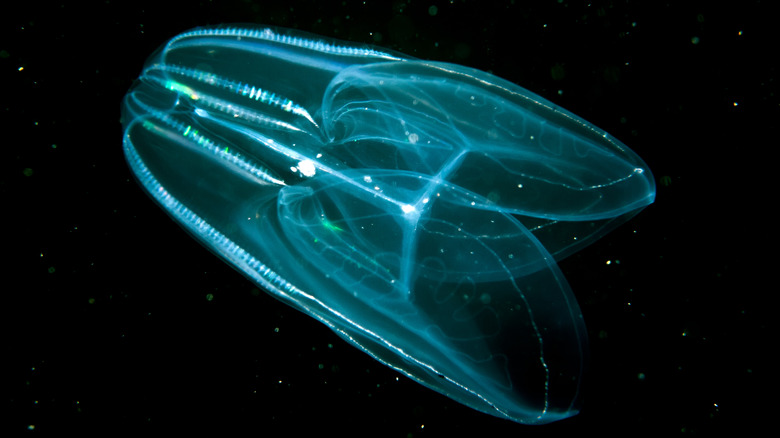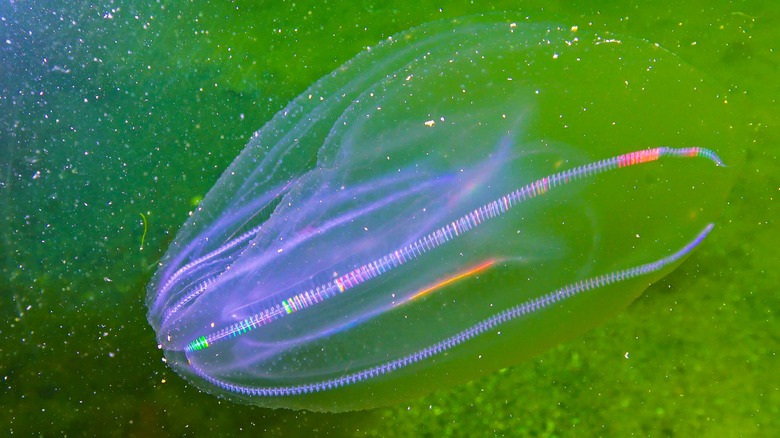Why Scientists Are Studying Diseases In One Of Earth's Oldest Animal Species
Neurological disorders like strokes, multiple sclerosis, brain injuries, Parkinson's, and Alzheimer's claim the lives of around 6.8 million people worldwide each year (via the World Health Organization). These disorders are also the largest cause of disability, according to Neurology Today, making them difficult for those affected and those who care for them. However, research conducted on comb jellies may be the key to treating these conditions, leading to a better quality of life for such patients.
The research, conducted by Leonid Moroz at the University of Florida and published in Nature in 2014, studied the neural systems of comb jellies because of the jellies' unique makeup. Essentially, their brains and neurological systems function in a way that is entirely different from ours. As Moroz puts it, "there is more than one way to make a brain" (via Reuters). By studying how these unique sea creatures are able to function differently from humans and other animals — they also differ from common jellyfish — we may be able to find a way to treat devastating neurological conditions.
The comb jelly's brain could be the key to treating human neurological conditions
The reason Moroz and his team chose the comb jelly for research is because of its unique molecular makeup. According to Reuters, it has different genes and neural transmitters than all other animals. One of the biggest differences between comb jellies and the rest of the animal kingdom is that they don't use serotonin, dopamine, acetylcholine, or most other neurotransmitters "that control brain activity in other animals," writes the University of Florida.
In humans, neurotransmitters play an important role in our basic functions. For example, Parkinson's disease is thought to be caused by low levels of dopamine, according to Medical News Today. Without these neurotransmitters, we are not able to function. Certain medications can affect the actions of neurotransmitters, such as Selective serotonin reuptake inhibitors (via Mayo Clinic), which are used to treat depression and anxiety by blocking serotonin from being absorbed, allowing more to be used by the brain (via Cleveland Clinic). Medications for neurodegenerative diseases also affect neurotransmitters to a degree, but there is no long-lasting cure for these conditions. If scientists were able to find out how the comb jelly's brain functions without the need for neurotransmitters, there may be a way to apply that research to humans, leading to better treatments and cures for neurological diseases.
Comb jellies are some of the oldest animal species still around
Besides its one-of-a-kind genetic makeup, the comb jelly also has a unique position on the evolutionary tree. According to Smithsonian, these seafaring creatures have been around for 500 million years, making them some of the oldest animals still around. The comb jelly isn't just ancient, either; it's practically alien. With translucent skin and shimmering rainbow "combs" running along its body, this otherworldly swimmer looks like nothing else (via Monterey Bay Aquarium). As researcher Leonid Moroz says, "If you met an alien you would assume it is radically different from us. There is no need to wait — these aliens are in our backyard" (via Nature World News).
With a unique brain and 500 million years of surviving as a species, there is a lot we can learn from the seemingly insignificant comb jelly. "What if we could not only slow the progression of Parkinson's or memory loss in aging, but reverse it?" Moroz asks (via the University of Florida). The comb jelly and its peculiar development may provide us with answers someday.


